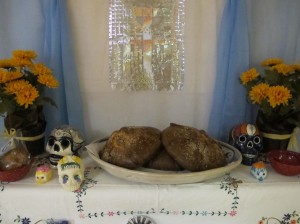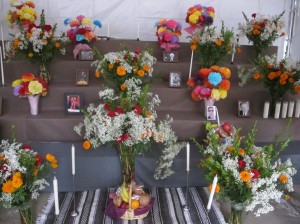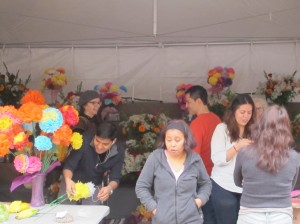Today is a great day to think about Mexican genealogy. What other culture embraces their ancestors with such joy and spirit? Today is the first day of Dia de los Muertos, or Day of the Dead, a two-day traditional Mexican holiday that honors family members who have past away. With roots in indigenous spirituality and colonial Catholicism, this holiday looks like Halloween and Christmas intermixed—colorful costumes, skulls and bones, elaborate make-up, house decorations, festive foods, and parades. It is traditionally celebrated on November 1 and 2 to coincide with All Saint’s Day and All Soul’s Day. But many families celebrate throughout the months of October and November. The centerpiece of this holiday is the special altar built and decorated almost like a Christmas tree.

“My mother would put several tables together to form one very long table for our altar. It stretched almost through our whole house!” said Maria Garcia, a Puebla native who lives and works in New York. “We would set a place for my grandparents and their grandparents. We included their photos and a name sign, favorite foods, colorful flowers, especially marigolds, candles and handmade and toy skulls,” Maria explained. Three categories of death are remembered: children, people who died of normal causes, and those killed, orphaned or who committed suicide. “For that last category, we would put their altar outside behind the house because their souls usually cannot ascend to heaven directly,” Maria said. Day 2 is for visiting the cemetery where gravesites are cleaned, decorated and offerings are left.

Family heirloom items are taken out of storage, such as her great-grandmother’s tablecloths and antique candleholders. Besides the many varieties of skulls, the children and family members place colorful tissue paper flowers with care above and around the table. Food and family stories take center stage during this time. Special bread called pan de muertos, bread of the dead, is a special altar offering and must not be eaten! The bread, similar to challah, is elaborately decorated with dough sculls and saint faces. Other major altar offerings include special chocolate disks, the basis of a spicy hot chocolate beverage, bowls of mole, and beer or mescal.

If you have Mexican ancestry and are interested in researching your family history, there are many websites and many resources available. Two sites that I like are: Mexican Genealogy and Cyndi’s list.
Have you ever been to a Dia de los Muertos event? Please share your experience in the comments section here.





Hello Sylvia, thanks for mentioning my blog. Growing up I can honestly say that this was the only real tradition that my family had. The second of November would come by and my father would take us to the two cemeteries where most of our ancestors are buried to put Coronas or flowers in their tomb stones. Though being raised in the Northern rural part of Tamaulipas, Mexio our experience was much different than the rest of Mexico. Your article does describe correctly how most of Mexico and parts of the United States celebrates it and growing up sometimes I would feel that we were different. It was not until years later that I discovered that our traditions are more Spaniard than most of Mexico.
Love your blog,
Moises Garza
http://www.mexicangenealogy.info
Hello Moises, Thank you for reading my blog post and your kind comments. I love your blog too! It is by far the best Mexican genealogy blog out there. I always send my Mexican friends to your site to get started on their family search. I would love to learn more about the’Spaniard’ tradition of this unique holiday.
Hello Richard, I had a similar reaction. I was shocked when I first encountered Dia de los Mueros in 1980 in California while working at the Oakland Tribune. Years later, as my genealogy activities expanded, I began to identify with the Mexican people’s reverence for their deceased family members. I agree, this unique holiday should give all of us insights into our own cultures!
I was first exposed to the Day of the Dead celebration when I worked at Macalester College in Minnesota. One of the Spanish professors had her class build alters in the vestibule of the college chapel. I have to admit that I was initially repelled by the skulls and crossbones on the alters. However, over the years I have come to admire and appreciate the tradition and i often think about what I might put on an alter commemorating my dad, uncle and grandparents. For me, it is an example of insights on my own culture gained from exposure to another.